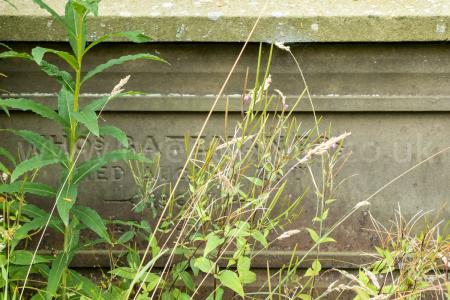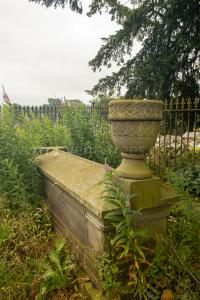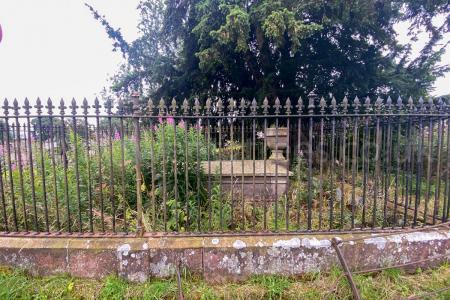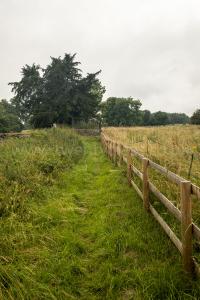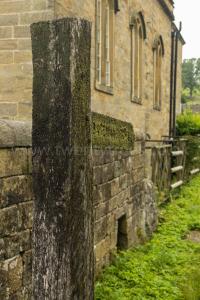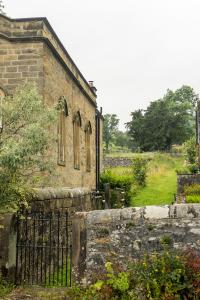Europe, British Isles, North-Central England, Derbyshire Dales, Middleton-by-Youlgreave [Map]
Middleton-by-Youlgreave is in Derbyshire Dales.
The River Bradford rises at Middleton-by-Youlgreave [Map] from where it flows to Alport [Map] where it joins the River Lath.
Europe, British Isles, North-Central England, Derbyshire Dales, Middleton-by-Youlgreave, Flax Dale Barrow [Map]
Flax Dale Barrow is also in Peak District Bronze Age Barrows.
Thomas Bateman 1846. On the 6th of February, 1847, a barrow [Map] [Flax Dale Barrow [Map]] was opened which is situated in the township of Middleton-by-Yolgrave, near a small valley called Flax-dale. It is of the usual bowl-shaped form, and is about three feet in height. Near the centre was found a fine sepulchral urn, neatly ornamented, containing a deposit of calcined bones, over which it was placed, with the mouth downwards. The urn was inclosed within a rude cist, partly cut in the rock, partly walled round, and covered with a large flat stone; about this and indeed throughout the barrow were many pieces of flinty some of which are chipped into the shape of arrow-heads &c. The presence of rats' bones indicated that there had been an interment by inhumation in addition to the foregoing one. Part of a skull and a few bits of pottery were all the vestiges of this deposit which appears to have been disturbed at the time of the interment of the urn and its contents.
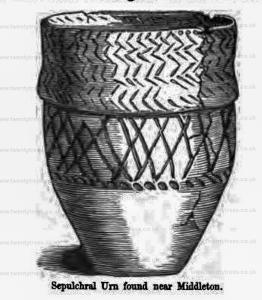
Middleton. On the 17th, 18th, and 19th of October, and 1st of November, some further researches were made in the Flax Dale Barrow [Map], near Middleton-by-Youlgrave, where a large cinerary urn with its deposit of burnt bones was found, in 1846. Although the present more extensive excavation was not equally successful, it afforded us an opportunity of becoming acquainted with a plan commonly adopted by the Britons in the construction of their tumuli, by first making a circle of large stones, within which the interments were placed, and then covered with an accumulation of stones, until a mound was formed surrounded by a kind of wall of one or two courses, consisting of the aforesaid circle; the whole was then covered with earth, which, though thinly laid on at the summit, was suffered to extend considerably further than the walled circle thus concealing all the stonework. The earth around the circumference of the barrow was very compact, particularly near the outside, and in some places abounded with pieces of melted lead and calcined flints, which led us to think it probable that fire had been employed to harden the earth whilst moist, with the intention of rendering the mound more durable. The only interment discovered on this occasion was just within the S.W. side of the stone circle: it consisted of a deposit of calcined bones which had originally been placed within an urn so imperfectly baked as to have almost become disintegrated, the decay having been accelerated by the atmosphere, eighteen inches of loose stone only covering the deposit. Some flints, fragmentary human bones, and a chip from a stone celt were casually found in the stony part of the mound.
The adjoining field is called Foggy Lees, which may be a corruption of Foggy Low.
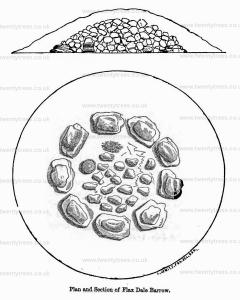
Europe, British Isles, North-Central England, Derbyshire Dales, Middleton-by-Youlgreave, Garratts Piece Barrow [Map]
Garratts Piece Barrow is also in Prehistoric Peak Distrct Roman and Saxon Barrows.
Section I Tumuli 1788. On the 15th of March, 1788, a farmer, who occupied the land on Middleton Moor, known as the Garratt Piece, having occasion to burn some lime upon that ground, dug for the purpose into a tumulus [Map] [Garratts Piece Barrow [Map]], or lowe, there situate.
He began his work on the outer edge of the barrow, clearing it away as he proceeded, to the level of the natural surface. On reaching the centre, he found, lying immediately under the usual depression of the summit of the barrow, and placed upon the level of the ground, a skeleton, whose extremities were towards the east and west; near the point of the shoulder was a very extraordinary ornament of copper neatly enamelled with various colours, red being the most predominant; it is circular, and has a hook in the form of a serpent's head, probably for suspension. In addition to this, part of another ornament of similar workmanship; part of the iron umbo of a shield and a shallow basin of thin brass, much broken and crushed, were found abont the same place. (For a similar basin see Archæologia, vol. xviii, page 80.) The design visible upon the circular and enamelled ornament is precisely similar to an illuminated capital Q in the Saxon manuscript entitled, 'Textus Sancti Cuthberti,' a production of the seventh century, formerly preserved in the cathedral of Durham, but now in the Cottonian library, (Nero, D. 4.) There is a good engraving of it in Astle's 'Origin of Writing,' plate 14, a. This interesting barrow was reopened by Mr. William Bateman (age 1), on the 19th of June, 1826, but was found to have been entirely rifled on the occasion above described.
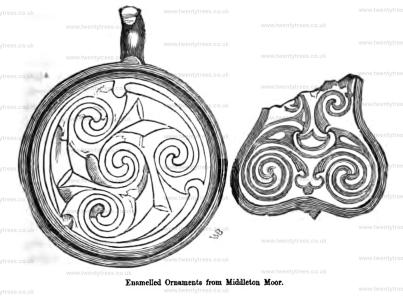
Archaeologia Volume 9 Section XVII. Discoveries in opening a Tumulus [Garratts Piece Barrow [Map]] in Derbyshire. In a Letter from the Rev. Mr. Pegge (age 83) to the Rev. John Brand, Secretary. Read May 8, 1788.
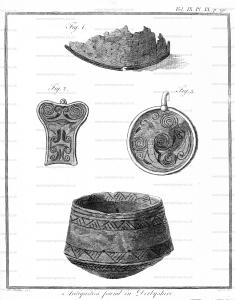
Section I Tumuli 1825. The only barrow yet discovered in a low situation in the neighbourhood of Middleton is placed in a meadow called Larks Lowe [Map], and near the rivulet called the Bradford; this tumulus was opened on the 20th of May 1825 when the cist was found to be constructed of large flat stones placed edge-ways with similar ones serving for the cover; it contained the decayed fragments of a human skeleton. On the eastern side of the barrow was found an urn of coarse earthy full of calcined bones and dry mould, the top protected by a flat piece of lime-stone, upon which was placed a small, shallow, earthen vessel very firmly baked, (of the kind denominated by Sir Richard Hoare (age 66) "incense cups"), a pin of bronze, two and a quarter inches long; several animal teeth and bones, amongst them a horse's tooth, a circular pebble, and a stone of peculiar shape; the large urn was of so friable a nature, that it probably had no other baking than what it received in the funeral fire, from this cause it was found impracticable to preserve it entire. June 19, 1826, it was thought advisable to reopen the very interesting barrow [Map] on Garratt Piece, Middleton, which was opened by Dr. Pegge in 1788, and described in the Archæologia, vol. ix, page 189; in it were found animal bones, one of which was calcined; a portion of the lower branch of an antler of the red deer, six inches in length, which had been tooled at the root by a sharp instrument; also some rats' bones. (See a subsequent examination of this barrow.)
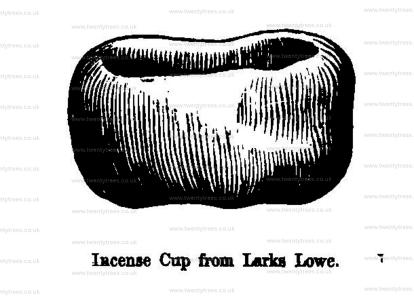
Thomas Bateman 1846. Upon reopening the remains of a barrow [Garratts Piece Barrow [Map]] upon Middleton Moor, explored by Dr. Pegge in 1788, on the 5th of October, 1847, a few small articles were recovered which indicate that the tumulus existed in times long anterior to the deposit of the very remarkable Saxon antiquities therein discovered and described in the earlier part of this section and which farther tend to strengthen the idea that in this part of the country there exist no barrows purely of Saxon origin. The articles with, the exception only of some fragments of light-coloured kiln-baked pottery, are of Celtic manufacture and usage, consisting of pieces of stags' horns, instruments of flint, amongst which was one of elongated shape very neatly chipped; and, lastly, remains of bone instruments, one of the latter presenting a very neat example of the lance-head of that material, being nicely worked into form out of the leg-bone of some small animal. Similar points are seen to some of the arrows brought from New Zealand.
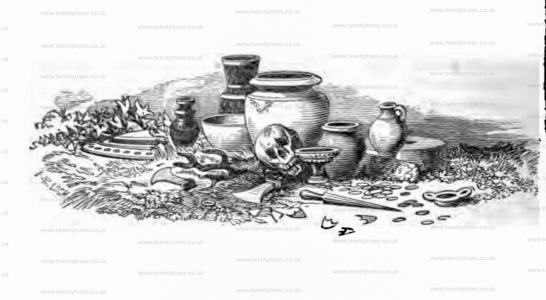
Europe, British Isles, North-Central England, Derbyshire Dales, Middleton-by-Youlgreave, Kenslow Farm [Map]
Europe, British Isles, North-Central England, Derbyshire Dales, Middleton-by-Youlgreave, Kenslow Farm, Kenslow Knoll Barrow 1 [Map]
Kenslow Knoll Barrow 1 is also in Peak District Bronze Age Barrows.
Section I Tumuli 1821. In February 1821, the Kenslow farm [Map], near Middleton-by-Yolgrave [Map], being planted and otherwise improved, a barrow [Map] was discovered upon the most elevated part of the land. In the nomenclature of Sir R. C. Hoare (age 62), it was a bowl barrow, composed of earth and stones, of about thirty feet in diameter, and its perpendicular height not more than three feet, with the usual shallow cavity on the top, five feet in diameter. The examination was commenced by a transverse section from the south side towards the middle of the tumulus. On approaching about six feet towards the centre a few human bones were discovered, promiscuously blended with those of a small animal, which Dr. Buckland has decided to be of the water rat (Reliquia Diluviana, plate ii, figs. 1, 2, 3, and 12), intermixed with a fine dry sand or mouldy slightly indicating calcination among which was a piece of ivory or bone the one side of which is convex the other flat with two perforations equidistant from the points which probably allowed of its being worn as a pensile ornament from the neck. In the centre of the barrow the rats' bones appeared in large quantities and in digging a little below the level of the natural ground the discovery of the primary deposit was made consisting of two skeletons one entire and the other nearly so laid at full length, about eighteen inches below the surface, in a cist or excavation of the soil, guarded nearly round, but particularly on the south and east sides, by large stones. The bodies had been deposited side by side, with their heads to the north-west; each head was placed in the hollow of a mass of magnesian lime-stone (of which the hill is composed), and reclining on the right side. Neither of them could be conveniently measured, but a thigh-bone was exactly eighteen inches in length, which, in a well-proportioned man, gives a height of about five feet ten inches. It is remarkable that not a tooth was wanting, or in the least decayed, in the jaws of either; and though, in one more particularly, the molars were much worn, as if by the mastication of hard substances, the enamel was still retained. The bones generally were but little decayed. One of the skulls appears to have been that of a man in the decline of life, and exhibits phrenological developments indicative of some of the worst passions incident to human nature. The other skull was crushed on removing the stone on which it lay. Near the bodies, and especially about the heads, a large quantity of the rats' bones and fine mould were strewed, with many round pebbles of various sizes, chiefly of quartz, which, in the opinion of Sir R. C. Hoare (age 62), were used in the sling. On the breast of the entire skeleton lay a circular fibula, or brooch, of copper or bronze. There was also a large quartz pebble and a fragment of pottery of red clay. Between the bodies was placed an axe- or hammer-head of basalt, in a decomposed state, and broken in the middle. In the same situation was found a porphyry slate pebble, highly polished, of very singular shape, four and a half inches in length, the same in medium circumference, the sides triangular and tapering towards the ends, which are rubbed flat. In vol, xii, p. 327, of the "Archæologia" a similar stone is described and engraved which was found in a barrow near Ashford-in-the-Water [Map] by Major Rooke. Behind the head lay a tusk apparently that of a dog and a molar tooth of the lower jaw of a horse. On these little if any decay seemed to have taken place.
Kenslow Barrow. February 1st we commenced re-opening the barrow [Map] [Kenslow Knoll Barrow 1 [Map]] upon Kenslow Knoll, which was formerly investigated by Mr. William Bateman, in 1821, when it appears that the primary interment was discovered, and besides it, some other relics which indicated that there might still remain additional deposits in that part of the barrow that was not then disturbed. By taking a wide trench through the middle of the barrow from the outer edge, it became apparent that its convexity had chiefly been preserved by a border of large limestones placed with great regularity on the surface of the natural soil. On clearing the area within them, many pieces of calcined flint and animal bones were picked up; also a splinter from a stone celt, a round piece of slaty sandstone which had been burnt, and a crescent-shaped ornament of bone having two perforations: the latter is precisely like one found at the prior opening, and gives the idea of a large canine tooth of a wolf split down the middle, being convex on one surface and level on the other, although in reality it is cut out of solid bone, and has been carefully polished all over.
Europe, British Isles, North-Central England, Derbyshire Dales, Middleton-by-Youlgreave, Kenslow Farm, Ricklow Dale Barrow [Map]
Ricklow Dale Barrow is also in Peak District Bronze Age Barrows.
. Note the location of Ricklow Dale Barrow [Map] is somewhat speculative.
Ringham Low. On the same day we examined a low mound [Ricklow Dale Barrow [Map]] a short distance east from Ringham Low, in the direction of Ricklow Dale, measuring about 14 yards across. It was so much destroyed as to yield no remains, except two pieces of an extremely thick human skull, and the usual rats' bones; in fact, the whole mound had been removed to within a few inches of the natural surface, on which lay some flat stones.
Europe, British Isles, North-Central England, Derbyshire Dales, Middleton-by-Youlgreave, Kenslow Farm, Ringham Low Round Barrow [Map]
Ringham Low Round Barrow is also in Peak District Bronze Age Barrows.
Ringham Low. On the 26th of February, another section was made in the barrow near Kenslow, called Ringham Low [Map], which had been examined twice previously without much success. A few more pieces of Romano-British pottery like that found before, indicated that three urns had been interred in the mound, which consists entirely of earth, and is much like the small barrow at Minning-low, opened 20th July, 1849.
Ringham Low. On the 5th of July, we opened another cist on the south side of the wall, which will be seen from the plan to cross the mound at Ringham Low [Map]. This (No. 4 on the Plan) when emptied, exhibited a fine and perfect specimen of primeval architecture, measuring in
Length 9ft
Width at east end 5ft 6in
Ditto at west end 2ft 6in
Depth 4ft
Six stones only were used in its structure, no pavement having been laid down. We left it in the same perfect state as we found it, having discovered only a few human bones, and a roughly chipped block of hard stone, which were embedded without order in a layer of stiff clay, immediately above the natural rock on which, the chamber was based; and a little charcoal at a higher level near the west end.
All the enclosures have been made by large slabs of limestone from the immediate vicinity, set on edge in narrow channels cut in the natural soil to the required shape of the chamber, and then secured in their respective positions by small stones firmly wedged between their sides and the solid earth. The tumulus in which they are distributed is composed of a vast accumulation of stones of all sizes, and is of irregular shape, as will be seen from the plan; its size may be stated as about 50 yards by 30, and its average height 4 feet.
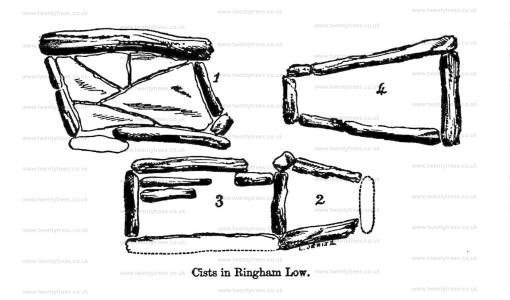
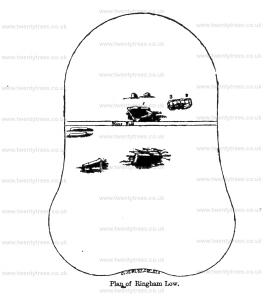
Llewellynn Jewitt 1870. The chambered tumulus, called the "Five Wells [Map]," near Taddington, of which an engraving is here given (fig. 64), has been a mound of large size, and the chambers and passages, or gallery, have been extensive. A plan of this tumulus is given in fig. 65. The "Five Wells [Map]" tumulus consists of two vaults or chambers, situated near the centre of a cairn (which is about thirty yards in diameter), each approached by a separate gallery or avenue, formed by large limestones standing edgeways, extending through the tumulus, respectively in a south-east and north-west direction. These chambers are marked B and G on the plan, G being the cist engraved on fig. 64. E E E are stones supposed to be the capstones thrown down. Another five-chambered tumulus in the same county is called Ringham-Low [Map], which has many interesting remains.
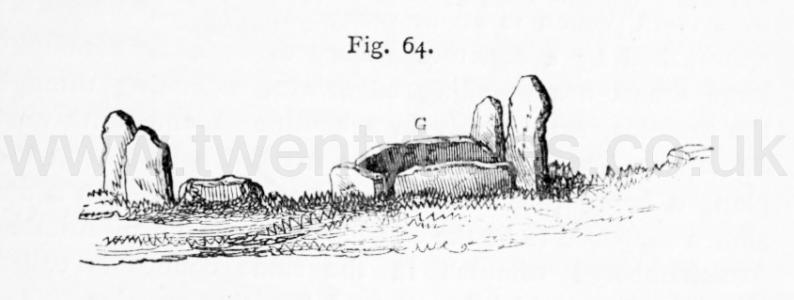
Europe, British Isles, North-Central England, Derbyshire Dales, Middleton-by-Youlgreave, Larks Low Barrow [Map]
Larks Low Barrow is also in Peak District Bronze Age Barrows.
Derbyshire Archaeological Journal Volume 30 1908 Page 155. May 20th, 1825. With somewhat better success we opened a tumulus not far from the village of Middleton, and on the low ground near the river Bradford1. The country people knew it by the name of Larks low [Map]. About the centre of the mount we discovered a cist formed of large stones set edgeways at the sides and ends with similar ones serving for a cover. It contained the decayed fragments of a human skeleton. On the Eastem side of the barrow, after removing a flat stone we discovered an earihern lamp2 (Fig. 1 in annexed plate) which I should consider Roman, and which was placed on the top of a large urn full of burnt bones and ashes. The urn being composed of clay, which had only been baked in the sun, fell into small pieces on the slightest touch, so that no part of it could be preserved. Fig. 3 presents the manner in which it was ornamented by zig-zag scratches, and from a segment of the circle measured on the spot it appears to have been 7 inches diameter on the rim and 4¼ inches diameter at bottom. Its general shape seemed to be like Fig. 4.3 - The lamp which had been well baked, and is in great preservation was 3¾ inches diameter and 2 inches high. Fragments of human bones, along with the teeth and bones of horses and other animals (among which the water rat was, as usual, conspicuous,) were scattered throughout the mount.
A copper pin, Fig 2.4. rather more than 2 inches in length, which had previously served as a fastening for the dress, was also found.
These barrows are situate in this manor of Middleton by Youlgreave, belonging to Thomas Bateman Esquire5, and were opened under the superintendence of Mr W Bateman and myself. - l am decidedly of opinion that they are all Roman or Romanized British6.
Note 1. lbid., p. 33.
Note 2. A so-called "Incense cup."
Note 3. This is hardly likely to be a correct restoration of the cinerary urn.
Note 4. Not copper, but bronze, Evidently an awl, not a pin.
Note 5. Father of William Bateman.
Note 6. This, of course, is a wrong surmise. They are all of the Bronze Age.
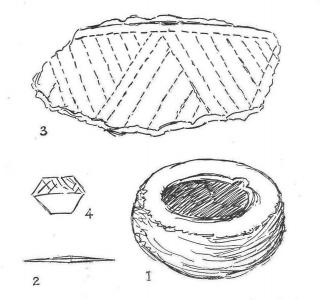
Section I Tumuli 1825. The only barrow yet discovered in a low situation in the neighbourhood of Middleton is placed in a meadow called Larks Lowe [Map], and near the rivulet called the Bradford; this tumulus was opened on the 20th of May 1825 when the cist was found to be constructed of large flat stones placed edge-ways with similar ones serving for the cover; it contained the decayed fragments of a human skeleton. On the eastern side of the barrow was found an urn of coarse earthy full of calcined bones and dry mould, the top protected by a flat piece of lime-stone, upon which was placed a small, shallow, earthen vessel very firmly baked, (of the kind denominated by Sir Richard Hoare (age 66) "incense cups"), a pin of bronze, two and a quarter inches long; several animal teeth and bones, amongst them a horse's tooth, a circular pebble, and a stone of peculiar shape; the large urn was of so friable a nature, that it probably had no other baking than what it received in the funeral fire, from this cause it was found impracticable to preserve it entire. June 19, 1826, it was thought advisable to reopen the very interesting barrow [Map] on Garratt Piece, Middleton, which was opened by Dr. Pegge in 1788, and described in the Archæologia, vol. ix, page 189; in it were found animal bones, one of which was calcined; a portion of the lower branch of an antler of the red deer, six inches in length, which had been tooled at the root by a sharp instrument; also some rats' bones. (See a subsequent examination of this barrow.)

Middleton. On the 24th of October, we opened a large trench in the barrow [Larks Low Barrow [Map]] at Larkslow, near Middleton by Youlgrave, which was first examined by Mr. William Bateman, in 1825, when amongst other things were found a cinerary urn, containing burnt bones, and an "incense cup." It appeared by our excavation, that the centre of the barrow had been surrounded by large masses of chert, within which circle the interment had been deposited. We discovered the calcined bones which had been emptied out of the urn at the former opening, and a few pieces of an unburnt skeleton. From a very careful examination of the former, we find them to consist of the remains of a full-grown person, and an infant, with whom had been calcined a few small instruments of flint, a bone pin, and a tooth of some large animal. It is probable that the critical examination of all deposits of burnt bones would lead to much curious information respecting the statistics of suttee, and infanticide, both which abominations we are unwillingly compelled, by accumulated evidence to believe were practised in Pagan Britain.
Europe, British Isles, North-Central England, Derbyshire Dales, Middleton-by-Youlgreave, Lomberdale House [Map]
John Lubbock 1879. About a quarter of a mile to the west, there is a large conical tumulus, known as Gib Hill [Map], which was connected with Arbor Low by a rampart of earth, which, however, is now very faint and imperfect. Gib Hill was opened: by Mr. Bateman in 1848. He found that it had been raised over four smaller mounds, consisting of hardened clay mixed with wood and charcoal. The central interment consisted of a dolmen, or stone chamber, situated near the top of the mound. It was composed of four massive limestone blocks covered by a fifth, about four feet square by ten inches in thickness. The cist, having fallen in, was removed, and re-erected in the garden at Lomberdale House [Map]. It contained only a small urn, four-and-a-quarter inches in height, a piece of white flint, and burnt human bones. In the earth of the tumulus were found also a flint arrow-head, a fragment of a basaltic celt, a small iron brooch, and another fragment of iron, supposed by Mr. Bateman to have belonged to a later interment, which had been previously disturbed. To the west, is the Roman Road from Buxton, which passes southwards, not far from Kenslow Top [Map] to the great tumulus of Minning Low [Map].

Europe, British Isles, North-Central England, Derbyshire Dales, Middleton-by-Youlgreave, Middleton Hall [Map]
In 1815 Thomas Bateman (age 54) bought Middleton Hall [Map].
Europe, British Isles, North-Central England, Derbyshire Dales, Middleton-by-Youlgreave, Moot Lowe Bank Barrow [Map]
Moot Lowe Bank Barrow is also in Peak District Bronze Age Barrows.
Thomas Bateman 1846. On the 7th of December, 1846, a barrow was opened which is situate upon the extremity of a hill-side near Middleton, called Moot Lowe Bank [Map]. There were very slight appearances upon the surface of the ground of anything of the kind, in fact, the sepulchral nature of the place was accidentally discovered by a labourer engaged in quarrying stone in the hillside. On examining the surrounding rock, a false joint, about two feet wide, became apparent, which extended a distance of seven yards in an oblique direction up the side of the hill; this joint had been filled in with stones and soil, amongst which many bones of animals occurred, all of the same description as are usually found in tumuli; near the upper end of the joint was placed a human skeleton doubled up in the usual primitive manner, close to whose head were four or five cows' teeth. Nothing more than these appeared to have been deposited with the body, which was that of an adult male.
Europe, British Isles, North-Central England, Derbyshire Dales, Middleton-by-Youlgreave, Oldham Farm [Map]
Europe, British Isles, North-Central England, Derbyshire Dales, Middleton-by-Youlgreave, Oldham Farm Barrow [Map]
Oldham Farm Barrow is also in Peak District Bronze Age Barrows.
Section I Tumuli 1825. Another barrow [Map], situated within a few yards of the Roman road, where it passes through the Oldham Farm [Map] at Middleton, yielded neither implements, human bones, nor rats' bones; only fragments of charcoal were noticed. (Fragments of coarse pottery have since been discovered in this tumulus.)
Section I Tumuli 1844. On the 30th of July, 1844, was re-examined a barrow [Map] upon the Oldham Farm, Middleton, which was unsuccessfully opened by Mr. William Bateman, on the 18th of May, 1825, nor was this second investigation much more interesting, as the barrow proved in most respects the same as the one on Ringham Lowe [Map], which is within half a mile of the one in question. There were the remains of a large fire visible in the centre of this mound, upon the level of the undisturbed soil, where were also some pieces of sandstone and some quartz pebbles, neither of which are to be found in the neighbourhood. The only articles of human origin were several pieces of kneaded clay, partially hardened by the fire, and a broken piece of coarse pottery of very hard texture.
Europe, British Isles, North-Central England, Derbyshire Dales, Middleton-by-Youlgreave, Rusden Low Barrow [Map]
Rusden Low Barrow is also in Peak District Bronze Age Barrows.
Middleton-by-Youlgreave. On the 10th of November we commenced excavating a barrow in a plantation near Kenslow Wood, called Rusden Low [Map], where a skeleton was found by the planters in May 1828. Being situated on a natural rising of the land it had been quite overlooked till the previous day, when it was noticed whilst shooting. The first step was to cut as near the centre as possible, and the result was the discovery of a skeleton, lying on its left side, with the knees drawn up, in a slight depression in the rock which was very near the surface. The lower extremities were quite undisturbed, although the upper part of the body had been much injured at a former period, perhaps by the planters. In the course of the day we found the relics described below, none of which occupied any well-defined position in connection with the skeleton, though they were not far from it. It will be seen that they are of various ages, commencing with a neat spear point of flint burnt white, and a tine of stag's horn, found near the feet of the body; and a flint arrow near where the head should have been. Outside the depression in which the body lay was part of a very neatly made comb, composed of several pieces of bone rivetted between two strong ribs of the same with iron pins: it had been furnished with teeth on both sides, which were nearly all broken away. The blade of a clasp knife of iron, apparently very ancient, as it is completely oxydized through the substance of the metal; and a small brass coin of Constantius Chlorus, reverse Victoriae Laetae Princ Perp.; teeth of animals, and pieces of Romano-British pottery were found throughout the cutting, which, with the comb, knife, and coin have probably been deposited with a much later interment than that which we found.
Europe, British Isles, North-Central England, Derbyshire Dales, Middleton-by-Youlgreave, Smerrill Barrow 1 [Map]
Smerrill Barrow 1 is also in Peak District Bronze Age Barrows.
Smerrill. On the 13th of June, we opened the second barrow [Smerrill Barrow 1 [Map]] on the contrary side of the ravine, a mound about 9 yards across and 2 feet high, surrounded by an irregular circle of large limestones, and showing the grey surfaces of many others that jutted through its grassy covering. We began our cutting on the west side, and continued it to the centre, where, after much labour, we uncovered a large grave of irregular shape, sunk in the rock to the depth of 5 feet; its average dimensions were 8 feet by 6; it was filled with stones, and had upon its stony floor, a coating of stiff clay in which was embedded the skeleton of a tall young man, who lay On his left side with his knees drawn up, and the head in an easterly direction; owing to the wetness of the clay, the bones were in an advanced state of decomposition, having become of the consistency of cheese; the skull was narrowed and otherwise posthumously distorted by the pressure of the overlying mass; and the femur measured 19½ inches, the tibia 16. Behind the pelvis lay a very beautiful drinking cup, 8¾ inches high, the exterior entirely covered with ornament: it lay on its side upon an assemblage of implements, consisting of a bone netting rule or modelling tool, 12 inches long, made from the rib of a large animal (horse or cow), neatly rounded off at each end, and reduced to a regular breadth and thickness throughout; a dagger 4¾ inches long, a spear head 3 inches long, and four other instruments of flint, all whitened by the action of fire. The usual rats' bones were present in this undisturbed and interesting tumulus.
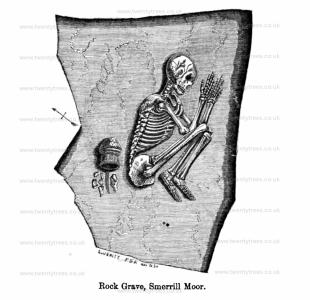
Europe, British Isles, North-Central England, Derbyshire Dales, Middleton-by-Youlgreave, Smerrill Barrow 2 [Map]
Smerrill Barrow 2 is also in Peak District Bronze Age Barrows.
Smerrill. On the 3rd of June, we opened the first [Smerrill Barrow 2 [Map]] of three barrows upon Smerrill Moor, near Middleton-by-Youlgrave, situated on the edge of the hill forming one side of a rocky but waterless valley. It measured about 11 yards across by 3 feet in height, was composed of earth and stones, and exhibited signs of former disturbance in the external appearance of a large stone in the centre, that had been removed from the side of a cist, which we afterwards found to consist of two compartments. The first had been plundered, and its contents were re-interred in confusion: they comprised bones from no fewer than twelve skeletons, of ages varying from infancy to senility, intermixed with a few pieces of calcined bone, charred wood, rats' bones, potsherds, &c., including jaws of two foxes or dogs, and a good spear head of white flint.
The second compartment was made by three large limestones placed on edge, their upper part appearing above the surface of the mound. It contained the skeleton of a female of rather low stature, who had been placed on her left side with the knees drawn up, and the head towards the north-east; a plain flake and a knife of flint lay at the head, and the bones were embedded in earth that had acquired a dark colour, apparently from the decomposition of wood; particles of charcoal, rats' bones, and fragments of earthenware of two sorts, were also present. The skull is remarkably small, and elevated in its contour, the occipital bone being much flattened, possibly by artificial compression in youth; the teeth indicate an age not exceeding 18 or 20 years, and the long bones are slender in proportion to the length; the femur measures 16½ inches.
Europe, British Isles, North-Central England, Derbyshire Dales, Middleton-by-Youlgreave, Thomas Bateman's Grave [Map]
After 28 Aug 1861 Thomas Bateman (age 39) was buried in unconsecrated ground at his request at Middleton-by-Youlgreave [Map].
